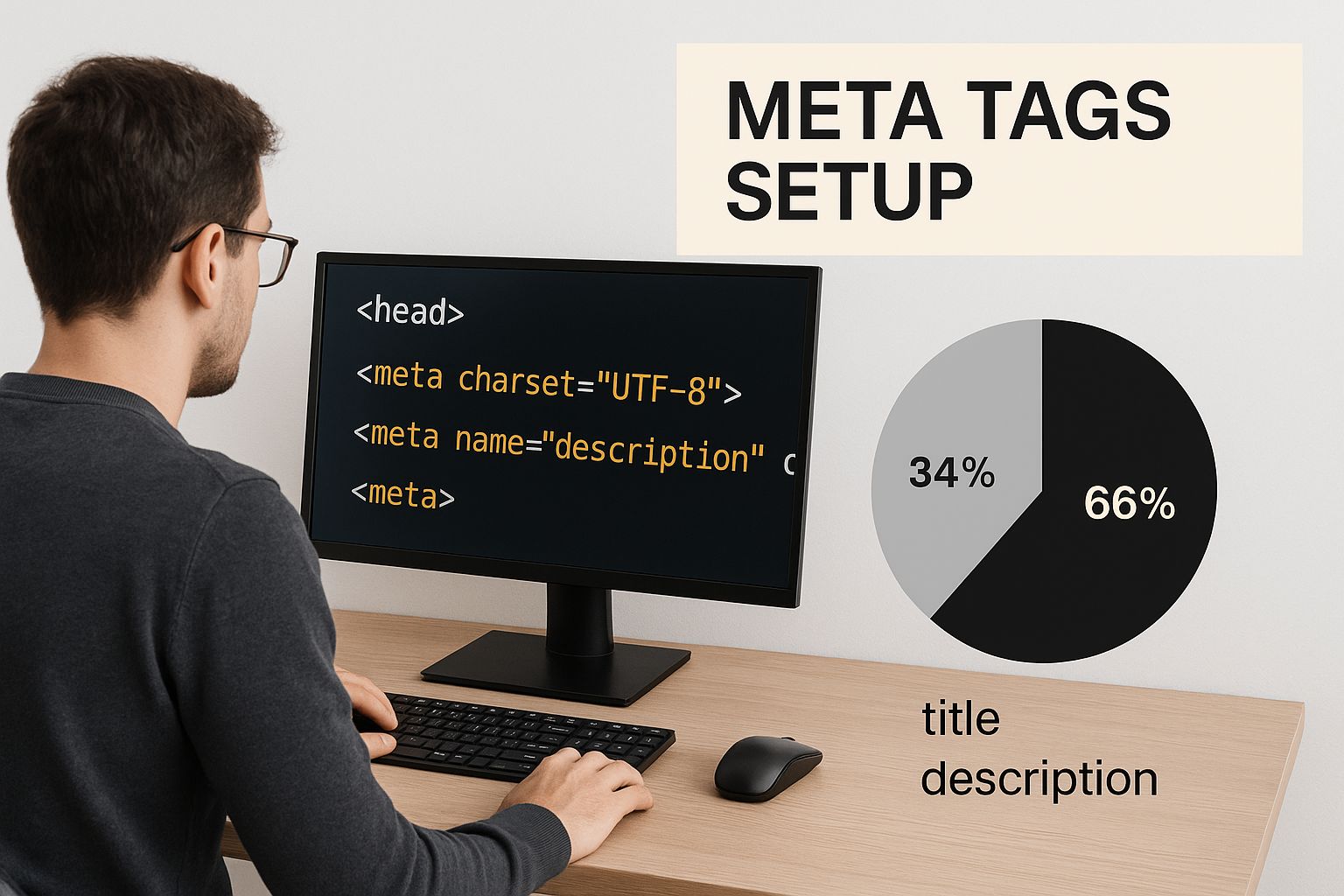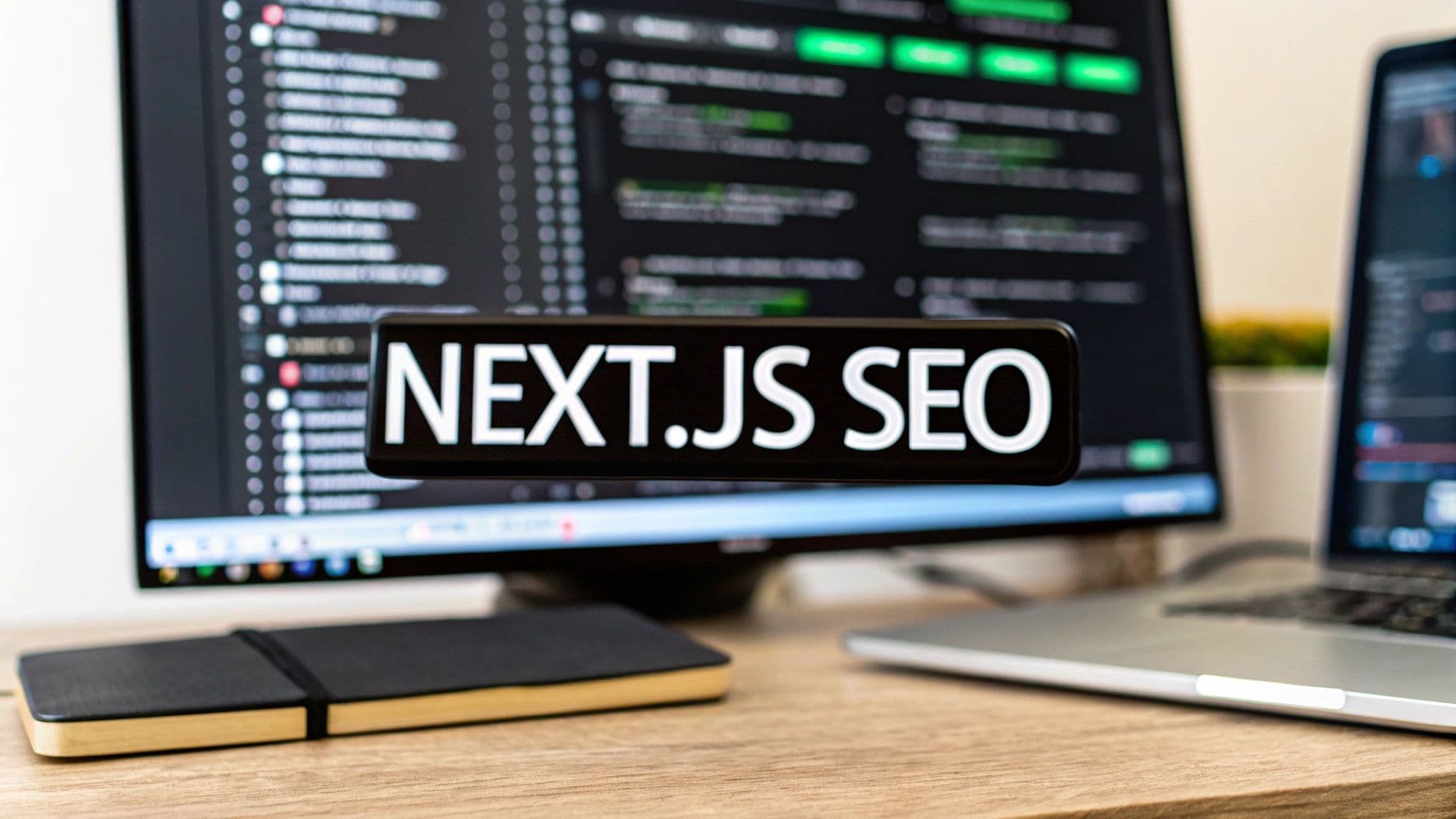next js seo
react optimization
web performance
static generation
core web vitals
Next.js SEO Tips: Boost Your Rankings with Proven Strategies
Why Next.js Changes the SEO Game
Next.js isn't just another JavaScript framework; it's a powerful tool that significantly improves SEO. Many development teams moving from traditional React applications find Next.js solves the SEO hurdles inherent in JavaScript-heavy websites. This improvement stems from Next.js's unique rendering approach and focus on performance.
Rendering Methods and SEO Impact
Next.js boosts SEO through its versatile rendering methods: Server-Side Rendering (SSR), Static Site Generation (SSG), and Incremental Static Regeneration (ISR). Each method offers unique advantages for search visibility.
- SSR: Delivers dynamic content while ensuring search engines receive fully rendered HTML.
- SSG: Generates static HTML files during the build process, resulting in blazing-fast load times.
- ISR: Combines the best of both worlds, enabling static pages that update incrementally in the background.
This flexibility empowers developers to tailor their approach to each project's specific needs.
Performance Boost and Core Web Vitals
Next.js's emphasis on performance directly translates to enhanced SEO. Features like automatic image optimization and built-in code splitting lead to faster load times – a critical factor in user experience and search ranking. These optimizations boost Core Web Vitals, Google's metrics for evaluating page experience.
Next.js applications, particularly those using ISR, see substantial improvements:
| Metric | Improvement |
|---|---|
| First Contentful Paint (FCP) | 50-70% increase |
| Time to Interactive (TTI) | 40% reduction |
| Bounce Rate | Up to 30% reduction (due to faster loads) |
Modern implementations now combine ISR with Next.js 15.2’s streaming metadata. This combination prevents rendering delays and ensures search engine crawlers receive fully formed HTML without hydration bottlenecks. For further statistics, check out this article: How Next.js Can Improve SEO
Bridging the Gap Between Developers and Search Engines
Next.js simplifies complex SEO implementation. Features like automatic sitemap generation, metadata management, and easy integration of structured data help developers adhere to SEO best practices.
This streamlined workflow frees developers to concentrate on building great features, confident their work is easily discoverable by search engines. The result is a more efficient development process and better organic search performance.
Mastering Core Web Vitals With Next.js
Next.js offers substantial SEO advantages beyond the basics. It empowers developers to achieve exceptional Core Web Vitals scores. These vitals are key performance metrics that Google uses to evaluate user experience, significantly impacting search rankings. This section explores practical strategies for optimizing each vital, transforming slow applications into fast, engaging experiences.
Optimizing Largest Contentful Paint (LCP)
Largest Contentful Paint (LCP) measures how long it takes for the largest content element (image, video, or text block) within the user's viewport to render. Optimizing LCP is crucial for perceived loading speed. Next.js's next/image component is key for this. It optimizes images by delivering appropriately sized versions based on the user's device and viewport, minimizing LCP render time. Also, consider using optimized image formats like WebP.
Eliminating Cumulative Layout Shift (CLS)
Cumulative Layout Shift (CLS) quantifies the visual stability of a page. Unexpected content shifts frustrate users and harm SEO. Next.js helps minimize CLS with features like next/image. By providing size information upfront, images load without causing layout shifts. Maintain consistent font loading with next/font to avoid text reflow issues.
Addressing First Input Delay (FID) With Next.js
First Input Delay (FID) measures how quickly a page responds to user interaction. A long FID indicates an unresponsive page, negatively affecting both UX and SEO. Next.js addresses FID by utilizing features like dynamic imports and component-level lazy loading. These techniques prioritize loading critical elements first, reducing the main thread's workload and improving responsiveness.
Real-World Impacts of Next.js on Core Web Vitals
Optimizing Core Web Vitals in Next.js produces tangible SEO benefits. Sites with 'good' scores across LCP, FID, and CLS see significantly improved organic traffic retention, between 20-35%. Next.js's automatic image optimization contributes to near-perfect CLS scores (below 0.1). Combined with other optimizations, Next.js applications demonstrate a 50% lower Total Blocking Time (TBT) than standard React implementations, directly improving FID. This performance advantage explains why Next.js powers 38% of new enterprise websites focused on SEO. Find more detailed statistics here.
Visualizing Core Web Vitals Improvements with Next.js
The following data chart illustrates typical improvements seen when migrating from a traditional React app to Next.js. It visualizes percentage improvements in LCP, CLS, and FID.

As the chart highlights, LCP improvements can surpass 60%, CLS is drastically reduced to near zero, and FID improves by over 40%. This visualization emphasizes the significant impact of Next.js on Core Web Vitals and overall SEO.
Let's delve into a more detailed comparison with this table:
Next.js vs. Traditional React: Performance Metrics Comparison This table compares key performance metrics between Next.js applications and traditional React applications, highlighting the SEO advantages of Next.js.
| Metric | Traditional React | Next.js | SEO Impact |
|---|---|---|---|
| Largest Contentful Paint (LCP) | Often higher due to unoptimized images and rendering | Significantly lower due to image optimization and optimized rendering | Improved LCP leads to better search rankings and user experience |
| Cumulative Layout Shift (CLS) | Can be higher due to dynamic content and layout changes | Near zero due to image size information and font optimization | Lower CLS improves user experience and search rankings |
| First Input Delay (FID) | Can be higher due to large JavaScript bundles and main thread blocking | Lower due to optimized JavaScript bundles and efficient rendering | Improved FID leads to a more responsive site and better search rankings |
This table summarizes the key advantages of Next.js in terms of Core Web Vitals, emphasizing how these improvements positively affect SEO.
Continuous Improvement and Debugging
Mastering Core Web Vitals is an ongoing process. Next.js provides tools for measuring, debugging, and continuously refining these metrics. Use browser developer tools and performance monitoring platforms to identify bottlenecks and track your progress. Consistent optimization ensures your Next.js application remains fast, user-friendly, and ranks highly in search results.
Technical SEO Implementations That Actually Work

Putting Next.js SEO into practice means implementing key technical elements effectively. This involves understanding how to optimize metadata, structured data, and sitemaps within both the App Router and Pages Router. The best approach depends on your project's complexity and your specific SEO goals.
Metadata Management in Next.js
Effective metadata management is essential for Next.js SEO. This means creating compelling titles and descriptions that accurately represent your content and encourage clicks. The next/head component allows you to inject dynamic metadata tailored to each page. This ensures search engines like Google receive the correct information about your content.
Implementing Structured Data With Next.js
Structured data, often using Schema.org vocabulary, helps search engines understand your content's context. This can result in rich snippets appearing in search results, boosting visibility. In Next.js, implementing structured data involves embedding JSON-LD within your components. This provides clear, machine-readable data that improves your search presence. You might be interested in learning more about integrating databases: How to master Supabase with Next.js.
Dynamic Sitemaps and API Routes
Dynamic sitemaps are essential for larger Next.js projects. Using Next.js API routes, you can generate sitemaps programmatically. This ensures search engines can discover and index all your content, especially important for sites with frequent updates.
Internationalization (i18n) for SEO
For projects targeting a global audience, internationalization is crucial for Next.js SEO. Implementing hreflang tags and locale-specific content helps search engines understand the language and region your content targets. This improves targeting and rankings in relevant search results.
Canonical URLs and Duplicate Content
Managing canonical URLs effectively prevents duplicate content issues. Next.js provides ways to specify canonical URLs for each page, consolidating ranking signals. This tells search engines which version of your content is preferred, building a stronger SEO foundation and avoiding penalties.
Balancing Developer Experience and SEO
Implementing technical SEO in Next.js can be tricky. It's essential to balance developer experience with SEO best practices. Aim for optimal SEO performance while considering implementation complexity and its impact on development workflows.
To help illustrate the different implementation strategies, the following table provides a detailed comparison between App Router and Pages Router.
The following table summarizes different implementation strategies for technical SEO in Next.js, comparing the App Router and Pages Router.
| SEO Element | App Router Implementation | Pages Router Implementation | Complexity Level |
|---|---|---|---|
| Metadata | metadata export in layout or page components | next/head component | Low |
| Structured Data | JSON-LD within components | JSON-LD within components | Low |
| Dynamic Sitemaps | API Routes | External libraries or custom server logic | Medium |
| Canonical URLs | metadata export | next/head component | Low |
The App Router often offers more streamlined methods for dynamic elements like sitemaps, while the Pages Router utilizes more traditional Next.js approaches. Understanding these differences empowers teams to choose the best path for their project. This comprehensive approach helps build a robust Next.js SEO foundation, improving search visibility and user engagement.
Static Generation: Your SEO Secret Weapon
Static generation continues to be a highly effective method for boosting SEO performance with Next.js. High-traffic websites utilize this technique extensively, and we'll explore the reasons behind its success. This involves understanding the key decisions developers face when choosing between Static Site Generation (SSG), Incremental Static Regeneration (ISR), and combining the two.
Choosing the Right Static Generation Strategy
Picking the correct static generation method is vital for maximizing your Next.js SEO. Full SSG is excellent when content remains relatively static. This method generates all HTML files during the build process, resulting in incredibly fast loading times. However, for sites with frequently changing content, full SSG can lead to lengthy build times and outdated information. This is where ISR becomes invaluable.
ISR lets you serve static content while refreshing it behind the scenes, combining the speed of SSG with the dynamism of Server-Side Rendering (SSR). It provides a good balance between performance and up-to-date content, making it well-suited for blogs, e-commerce product listings, and other dynamic content. You might find this helpful: How to master Next.js landing page templates.
Implementing Content-Aware Regeneration
For more granular control, developers are adopting content-aware regeneration strategies. This involves triggering ISR updates based on specific events, like content changes within a Content Management System (CMS). This approach guarantees content is refreshed only when required, optimizing build times and minimizing outdated information.
Managing Build Times for Large Sites
One common obstacle with static generation, especially for large websites, is managing long build times. Optimizing data fetching and utilizing tools like next/image for image optimization can dramatically reduce these times. Additional optimization strategies might include generating only crucial pages during the build process and using ISR for less vital sections.
Maintaining Content Freshness
Keeping your content fresh is essential for good SEO. ISR provides a way to automatically refresh static pages, ensuring search engines always have access to the latest version. Finding the right balance between fresh content and efficient build times requires careful consideration. Developers can analyze website traffic and user activity to determine the most effective refresh intervals.
Real-World Applications of Static Generation
E-commerce platforms utilize SSG and ISR to improve product page visibility and boost search rankings. Content creators use ISR to publish current articles without slowing down their websites. Even Software as a Service (SaaS) applications leverage these techniques to optimize landing pages and documentation, improving both SEO and user experience. These real-world cases highlight the flexibility and effectiveness of static generation across a variety of web applications. Static generation in Next.js, whether it’s full SSG or ISR, allows developers to build high-performing, SEO-friendly websites that provide excellent user experiences. By implementing these strategies effectively, businesses can improve their search visibility, attract organic traffic, and achieve their SEO objectives.
Beyond Basics: Advanced Next.js SEO Techniques

For development teams looking to elevate their SEO game, this section dives into advanced Next.js SEO techniques designed to give you a competitive advantage. These strategies focus on optimizing how search engine crawlers render your content, enhancing content delivery, and utilizing serverless functions for more targeted SEO approaches.
Streaming Server Components and Partial Hydration
Streaming server components in Next.js significantly improve how search engines crawl and index your website. By delivering HTML in smaller chunks, crawlers can start processing content before the entire page fully loads. This results in faster indexing and potentially higher search rankings.
When combined with partial hydration, which prioritizes loading interactive elements first, you create an optimal experience for both search engines and users. Partial hydration boosts metrics like First Input Delay (FID) and Time to Interactive (TTI), allowing users to interact with the page sooner.
Leveraging Edge Functions for Geo-Targeted SEO
Edge functions offer another powerful tool for Next.js SEO. They enable you to deliver personalized content based on a user's location. This is particularly valuable for internationalization efforts.
For instance, you can display different product listings, pricing, or even translations based on the user's region. This improves user experience and bolsters your SEO strategy across different markets.
Advanced Structured Data and Crawler-Specific Rendering
Optimizing structured data is key for achieving rich search results. Next.js allows you to implement advanced structured data using React components, ensuring consistency and maintainability.
Furthermore, by creating specific rendering paths for crawlers, you guarantee search engines receive streamlined HTML, free of unnecessary JavaScript that might hinder indexing. For a more detailed approach to Next.js, consider exploring this resource: How to master Next.js with a starter template.
Building a Sophisticated Internal Linking System
Internal linking, though often overlooked, is a vital aspect of SEO. A well-structured internal linking system enhances site navigation and distributes link equity across your pages.
Next.js allows for automated internal linking using dynamic routes and programmatic linking based on content relationships. This helps ensure your most important pages receive the most internal links, improving their authority and search visibility.
Measuring SEO Impact with Server-Side Analytics and A/B Testing
Finally, consistent measurement and iteration are crucial for any SEO strategy. Implementing server-side analytics provides insights into crawler behavior and page performance without affecting client-side loading times. This data allows for accurate tracking of SEO improvements.
Running A/B tests on SEO changes, without impacting your current rankings, enables you to refine your optimizations. This data-driven approach promotes continuous improvement and ensures your Next.js SEO strategy stays effective and aligned with your goals.
Industry-Specific Next.js SEO Strategies
Different business models require specialized Next.js SEO approaches. Let's explore how various sectors can use Next.js to improve their search visibility.
E-commerce SEO with Next.js
E-commerce sites face unique challenges, especially with faceted navigation, product schema, and inventory indicators. Next.js helps address these without impacting performance.
-
Faceted Navigation: Next.js allows for dynamic URLs for faceted navigation. This enables search engines like Google to crawl and index product categories efficiently. It also improves the user experience by simplifying product filtering.
-
Product Schema: Implementing rich product schema markup with Next.js helps search engines understand product details like pricing, availability, and reviews. This can result in enhanced search results with rich snippets, ultimately boosting click-through rates.
-
Inventory Indicators: Keeping inventory information up-to-date is essential for e-commerce. Next.js allows developers to display live stock data, minimizing user frustration and cart abandonment. Accurate product data also benefits search engines.
Content Publisher SEO with Next.js
Content publishers using Next.js can optimize article structured data, improve content recommendation systems, and manage content migrations effectively.
-
Article Structured Data: Next.js simplifies the implementation of detailed article structured data. This helps search engines understand the content's context, which can increase visibility in search results and user engagement.
-
Content Recommendation Systems: Integrating effective recommendation systems is possible with Next.js without performance issues. Suggesting related articles keeps users engaged and improves site navigation, indirectly boosting SEO.
-
Large Content Migrations: Migrating large amounts of content can be challenging. Next.js provides a reliable framework for this process, ensuring correct URL redirects and preserving SEO value.
SaaS SEO with Next.js
SaaS applications can optimize feature pages, documentation, and user-generated content using Next.js.
-
Feature Page Optimization: Next.js enables the creation of fast-loading, SEO-friendly feature pages highlighting key benefits. Clear content, combined with effective metadata and structured data, improves search visibility and attracts qualified leads.
-
Documentation SEO: Well-written documentation improves user experience and attracts organic traffic. Next.js facilitates the creation and management of searchable documentation, allowing potential customers to find answers quickly. This, in turn, boosts SEO.
-
User-Generated Content (UGC): For SaaS platforms with UGC, Next.js provides the necessary structure for indexing and optimizing this content. Effective UGC management builds community and provides keyword-rich content for attracting organic traffic.
By adapting your Next.js SEO strategy to your industry's specific needs, you can maximize search visibility, improve user experience, and achieve your business goals.
Launch your AI-powered micro SaaS project quickly with AnotherWrapper! It provides everything you need, including Next.js SEO optimization features, to build and scale your product efficiently.
Fekri




